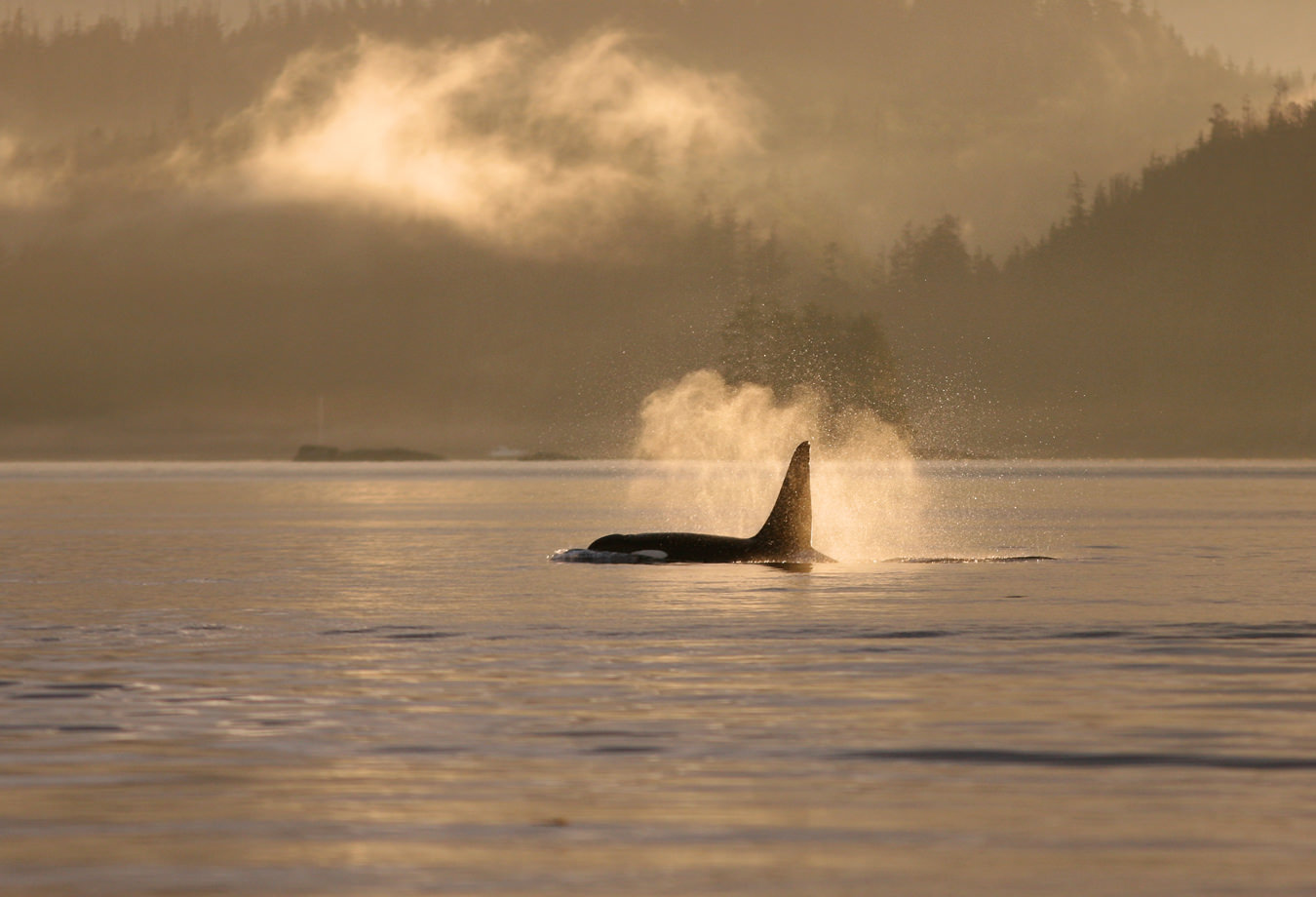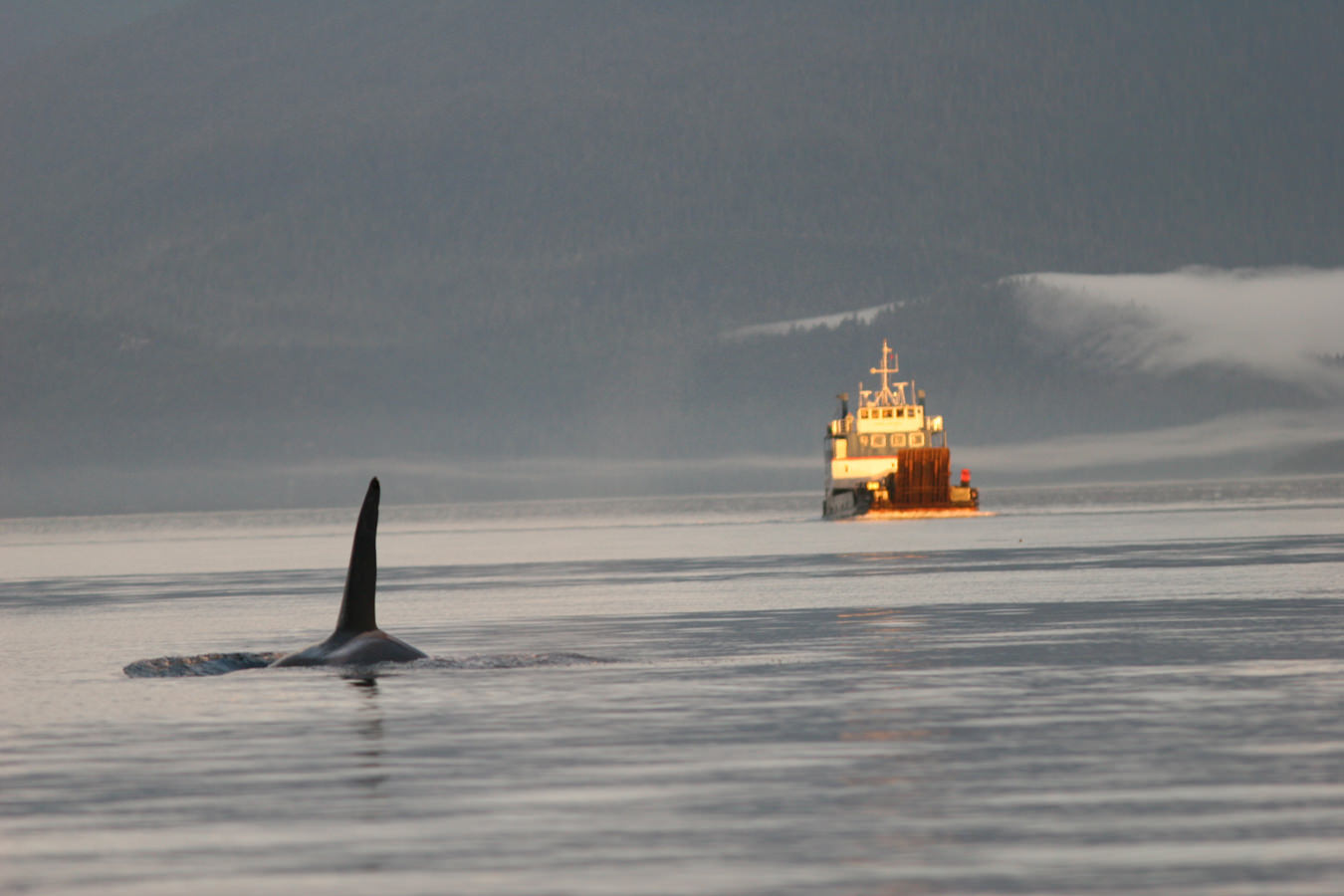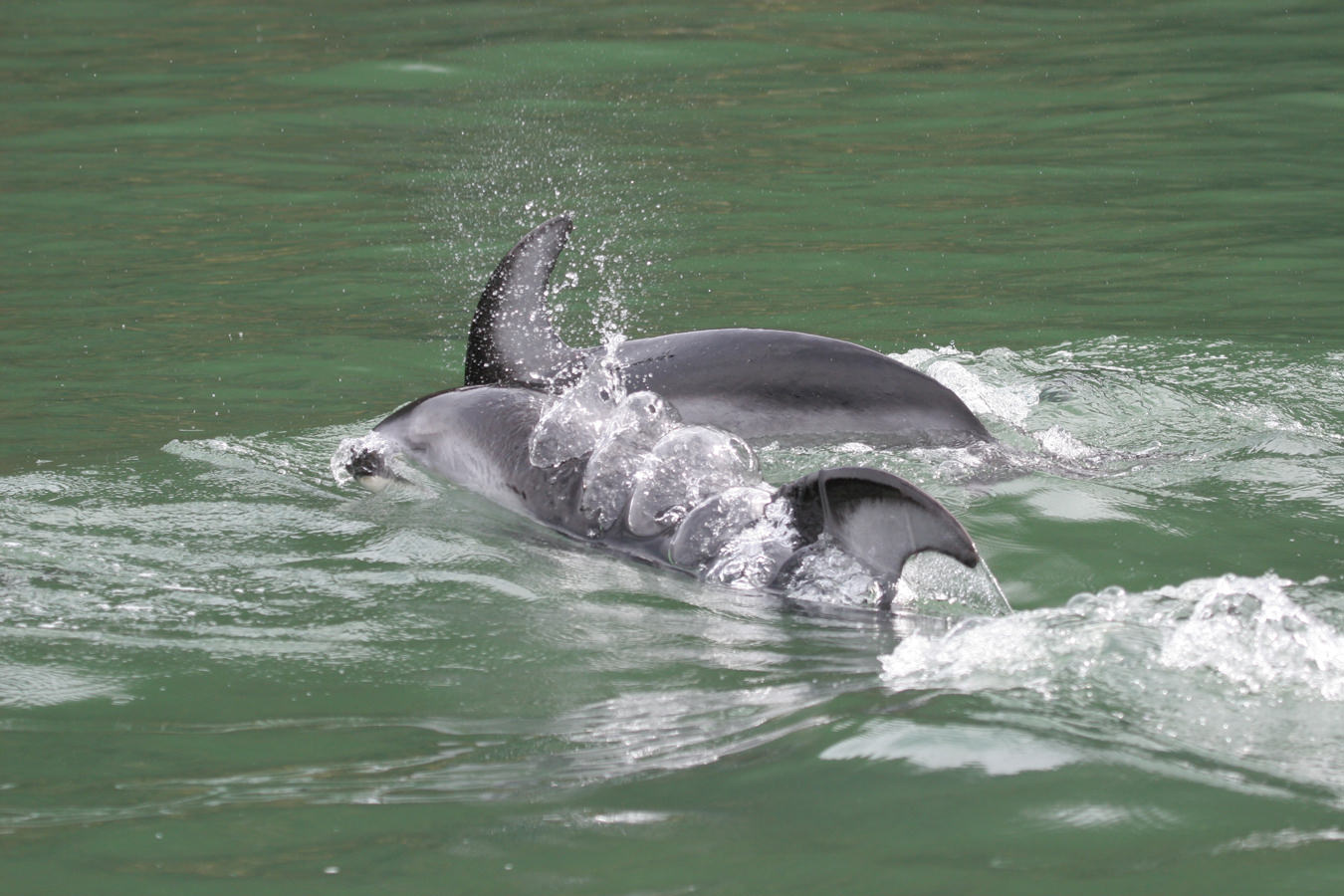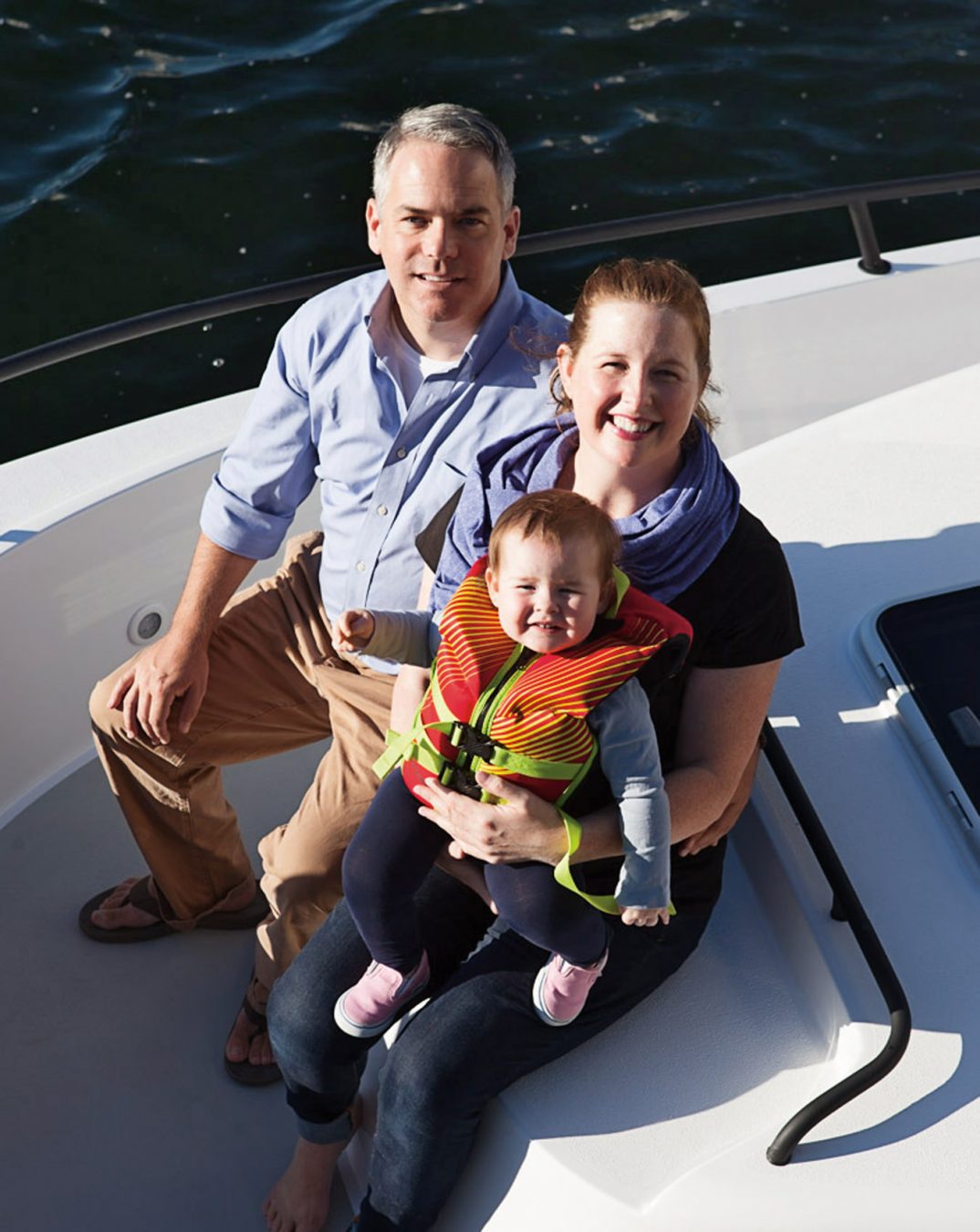Marine conservation biologists Erin Ashe and Rob Williams are slowly motoring a 10-metre-long boat along the calm, glittering waters of Broughton Archipelago near the northern tip of Vancouver Island, snapping identification photos of the fins of Pacific white-sided dolphins. Suddenly, the “relaxed vibe,” as Ashe describes it, changes dramatically, with hundreds of dolphins leaping out of the water, heading for the shoreline at high speed. Confused, Ashe and Williams look around and spy a male killer whale about 100 metres abeam, appearing to fly through the air in breathtaking arcs, gaining on the fleeing dolphins. The couple then sees the dim but unmistakable silhouette of a female killer whale tucked in the wake of their boat. The sound of the motor, the couple later realized, provided perfect acoustic camouflage for the whales as they began their stealthy hunt. Within short order, the big male cuts a dolphin out of its school with the ease of a border collie herding sheep, dives underneath it and head-butts the doomed creature. The next thing Ashe and Williams see is the dolphin’s heart and lungs floating to the surface.
Ashe and Williams are leading the way in conducting research and raising awareness about the ecological effects of underwater noise on marine creatures—large and small—among government agencies and environmental groups. Founders of the Canadian charity Oceans Research and Conservation Association (ORCA) and the NGO Oceans Initiative, they have been sounding the alarm about underwater noise pollution for over a decade. The pair of hunting killer whales that cleverly used the chugging of the couple’s outboard motor to mask their underwater stalking indicate, says Williams, that the cacophony of marine underwater noise will have some surprising and unpredictable effects on the ecosystem—benefiting some species, proving disastrous for others. In this singular case, the killer whales used the boat noise to their advantage. More commonly, increasing underwater noise is putting whales at risk—especially Vancouver Island’s southern resident killer whale families, beloved by British Columbians as well as tourists who come from around the world to catch a glimpse of these massive creatures in their sleek, black-and-white attire, and listen to their explosive exhalations as they surface.
Ashe and Williams are leading the way in conducting research and raising awareness about the ecological effects of underwater noise on marine creatures.
There are many causes for concern, including underwater noise, for the southern resident killer whales—a dwindling group of 81 individuals, down from more than 100 in 1995. They summer in Haro Strait, the entranceway to the port of Vancouver, but have been seen as far south as California. The declining numbers mean the group is classified as endangered by the Committee on the Status of Endangered Wildlife in Canada (COSEWIC) and Canada’s Species at Risk Act (SARA). The northern resident killer whale population of a few hundred, found from Northern Vancouver Island to Northern British Columbia, is deemed threatened by COSEWIC and SARA. Agencies in the United States and Canada have identified that southern resident killer whales are threatened by stressors, namely fewer chinook salmon and high levels of toxic chemicals in the ocean that bioaccumulate through the salmon and are stored in whale blubber, which is then passed on to nursing calves through their mother’s milk.
Ashe and Williams first met 15 years ago, both of them young academics studying marine conservation, their summer laboratory the waters of the Pacific Northwest. American-born Ashe—now a Canadian resident—earned her PhD in marine biology from Scotland’s University of St Andrews. Williams, who was raised on Vancouver Island, is an alumnus of UBC and studied with Ashe at St Andrews on a Marie Curie fellowship. They married and now have a one-year-old toddler named Clara Bay, heir to her mother’s pre-Raphaelite red tresses. Following the birth, Ashe was warned by well-meaning colleagues that her field study days were over. However, the couple is determined to follow researchers like primatologist Jane Goodall and B.C. biologist Alexandra Morton, both of whom famously took their young children into the field. For Ashe and Williams, safety is key; the small motorboat they used for research had to be replaced by a larger vessel with high gunwales to prevent passengers from going overboard. To profile other scientist moms and share how they incorporate their children into their fieldwork, Ashe started a blog called Moms in the Field. She was thrilled when Margaret Atwood gave her permission to post a cherished family photo that showed the literary legend as an eight-year-old in the bush with her entomologist father. Atwood strongly supports the couple’s work: “If the oceans die, so will we,” she says. “It’s as simple as that.”
Ashe and Williams are widely published in respected journals such as Conservation Biology. This past spring, they were both recognized with prestigious grants to carry on their work. Oceans Initiative received a $27,000 grant from the National Geographic Society to support Ashe’s project on dolphins, while Williams received a $150,000 Marine Conservation Fellowship from The Pew Charitable Trusts in the States; the award recognizes a track record of excellent research and a vision for ocean conservation. “It was humbling to receive these awards,” says Williams. “It means that the people we admire tremendously value our science.” Ashe is one of the few people to ever systemically track dolphins in B.C., along with Alexandra Morton, whom Ashe considers a mentor. Morton, who is currently focused on the environmental impact of B.C. salmon farms, shared her dolphin data, compiled over several decades, with Ashe, who then added several years’ worth of information. Today, dolphin numbers can still only be roughly estimated, partly because there is a lack of funding for research on this species.
“Resident killer whales have the tightest social networks of any mammal, including humans.”
Access to food is directly linked to underwater noise. Cetaceans (whales, dolphins, and porpoises) communicate using lyrical combinations of songs, clicks, and grunts; some also use echolocation, a form of sonar similar to the acoustic tool that bats use to navigate in the dark. Echolocation clicks are projected out of the fatty acoustic lens in a cetacean’s forehead, then bounce off objects many kilometres away and boomerang back into the animal’s inner ear. When orcas are in a pod, they split up to hunt, communicating through social calls and echolocation. If an orca finds a school of chinook salmon, a favourite due to its large body size and high fat content, the whale will likely send signals to let family members know where dinner is being served. In a paper published with acoustics experts at Cornell University, Williams and Ashe found that, in busy Haro Strait, with its constant drone of tankers and smaller craft, 62 per cent of the time that a whale calls to its pod, that signal is drowned out. During high-traffic periods, calls may be missed 97 per cent of the time, says Williams. Killer whale communication goes beyond the question of “What’s for supper?”, though—it is also used for mate selection. Each pod has its own unique dialect, which helps identify mates outside of the family unit. “Their acoustic dialect is a wonderful mechanism to avoid inbreeding,” says Williams. “Resident killer whales have the tightest social networks of any mammal, including humans. Family is everything to them, and when we mask their ability to communicate, they can’t share information on fish or mates.”
Ashe and Williams have shown that man-made ocean noise is making orca and dolphin survival increasingly precarious. The Pew Charitable Trusts and National Geographic Society grants will help ensure they have the means to continue their work for the next three years. Importantly, their latest research gives Canadians the opportunity to discuss creating acoustic sanctuaries for marine wildlife—places where cetaceans already congregate but have little vessel traffic—giving whales and other marine creatures relief from the acoustic muddling of their watery home.
Wildlife photography courtesy of Erin Ashe and Rob Williams.


















